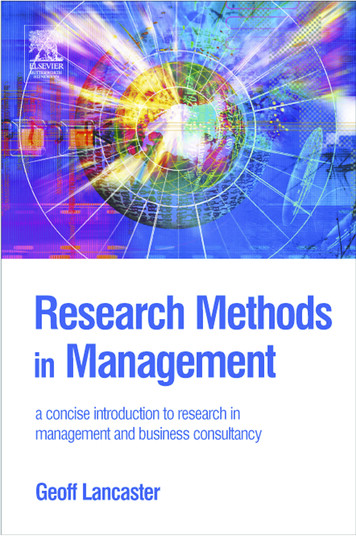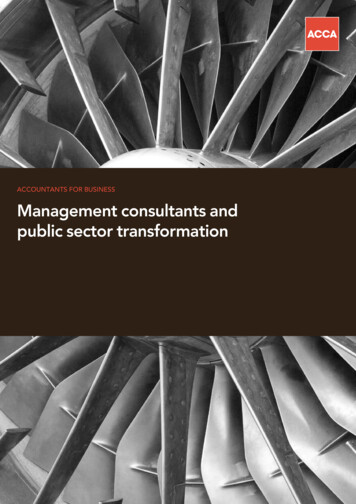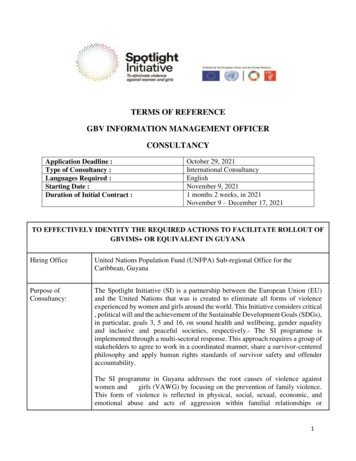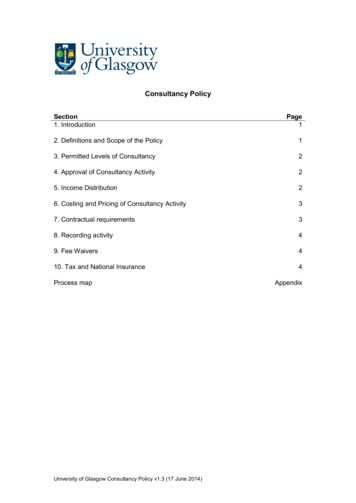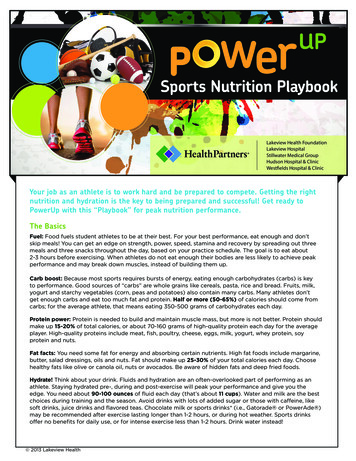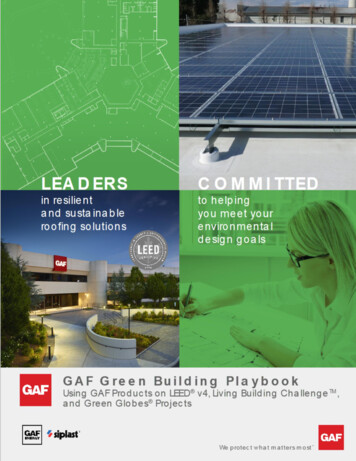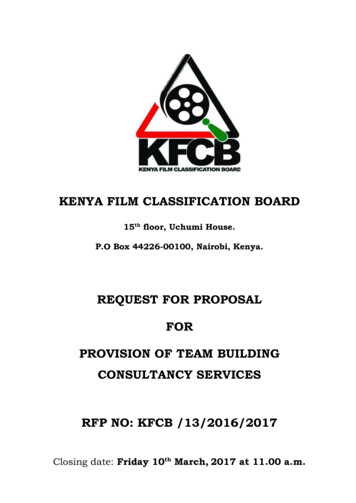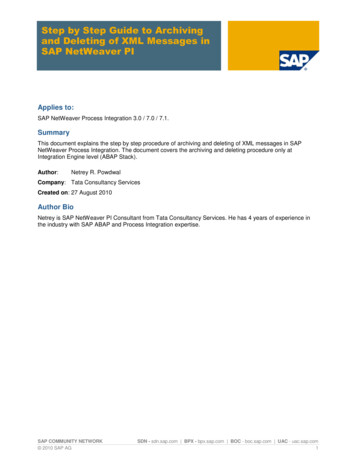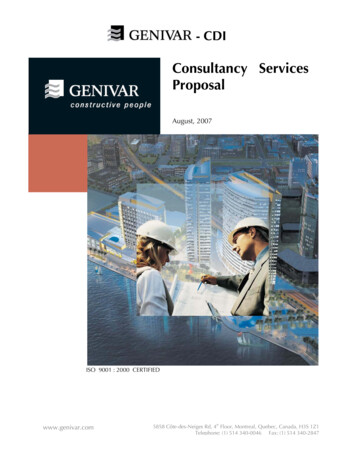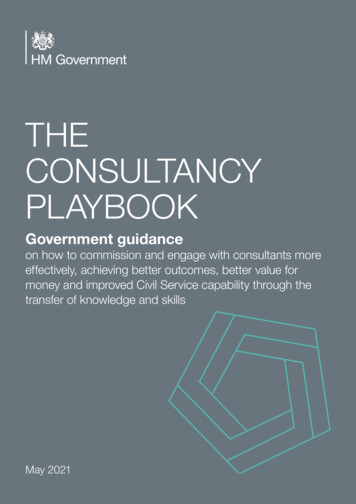
Transcription
THECONSULTANCYPLAYBOOKGovernment guidanceon how to commission and engage with consultants moreeffectively, achieving better outcomes, better value formoney and improved Civil Service capability through thetransfer of knowledge and skillsMay 2021
Crown copyright 2021Produced by Cabinet OfficeThis publication is licensed under the terms of the Open Government Licence v3.0 except whereotherwise stated. To view this licence, visit /version/3Where we have identified any third party copyright information you will need to obtain permissionfrom the copyright holders concerned.Alternative format versions of this report are available on request d by Design102
ContentsForeword3Introduction5Scope5Consultancy Playbook flow diagram61 Right at the start8Choosing the right delivery modelSetting procurements up for successEngaging with the market2 Going to marketWriting effective specificationsWriting evaluation criteriaRoutes to marketPricing and payment mechanismsEvaluating bidsData capture3 Maximising value throughoutBeing an effective clientKnowledge generation and transfer8111214141516182021242426
2
ForewordConsultants can bring highly valuableexpertise to support us in deliveringoutstanding public projects. It is essentialthat we continue to be able to access theright skills at the right time, but also that wedo so in the right way and deliver the desiredoutcomes. Government and the consultancymarket are committed to working togetherto get the most value from our spend and toachieve the highest quality results.While consultancies can help solve someof our most complex problems, they comewith high associated costs. Consultants canoffer us access to wide ranging and valuableexpertise, but we should recognise we getthe best results when we commission them tosolve specific problems. As such, the publicsector should be using market knowledgeto find the best solutions, and workingcollaboratively to deliver them. This approachwill also help to guard against ‘land andexpand’ behaviours that blunt delivery focusand diminish the good work that is done.It is crucial that government and industryact together to get this right.To do this, the Government CommercialFunction has partnered with the GovernmentConsulting Hub to develop the ConsultancyPlaybook, which sets out how to get the bestfrom our consultancy engagements. It givesguidance on how to engage with the marketto encourage innovation, to write effectivespecifications on what consultants will deliver,and to collaborate to achieve meaningfuland measurable knowledge transfer. This willcontribute to the development of the skillsand expertise we need to become a better,more self-sufficient Civil Service that is lessreliant on external resource.By following this Playbook, and the others inthe series of Playbooks, we can expect to getthings right at the start, maximising the valueadding potential of consultants whilst buildingour Civil Service capability and, particularly,delivering value for money for taxpayers.We are delighted to support the launch of theConsultancy Playbook and its implementationacross government.Gareth Rhys WilliamsGovernment Chief Commercial OfficerRupert McNeilGovernment Chief People Officer3
IntroductionConsidering when and how to use consultancyservices effectively is vital to the successof our projects and services. This Playbookfocuses on getting consultancy engagementsright at the start, ensuring that we are usingconsultants in the right instances to solvespecific problems, and avoiding over relianceon external support. This approach will deliverboth value for money and better qualityprojects and public services for the citizensthat use and rely on themBy following this guidance we can expect to: understand when consultants can add themost value when necessary, set our procurements upfor success achieve more favourable outcomes whengoing to market be a more effective client of consultantswhile building meaningful relationshipswith our suppliers improve Civil Service capability bymaximising knowledge generation andtransfer across the contract lifecycleThe Playbook has been co-developedwith the Government Consulting Hub, withinput from industry stakeholders and publicofficials, as part of the wider consultancyreform agenda to transform how governmentengages with the consultancy market.We expect the market to work with us toimplement these reforms and maximise thebenefits for both client and supplier.ScopeThis guidance applies to all centralgovernment departments and their arm’slength bodies (ALBs) when considering goingto market for any consultancy services, andshould be considered by local authoritiesand the wider public sector. The ConsultancyPlaybook forms part of the SourcingPlaybook. As such, the principles, guidelinesand rules of the Sourcing Playbook stillapply and shall be considered alongside theConsultancy Playbook where appropriate.This Playbook broadly defines ‘consultancy’as the provision of objective advice relatingto strategy, structure, management oroperations of an organisation that is outsidethe ‘business-as-usual’ environment andoften includes the identification of optionswith recommendations or assistance with theimplementation of solutions. We recognisethat there is no one-size-fits-all approachto consultancy requirements. As such, theprinciples outlined here shall be implementedby departments and their ALBs on acomply or explain basis and be applied bycontracting authorities proportionately to thevalue, scope and duration of the engagement.5
Consultancy Playbook flow diagramFigure 1. Building the Playbook into the typical procurement process (over two pages)Commerciallife cycleDefineChoosethe rightdeliverymodelKey actionsEngagewith themarketPlanknowledgegenerationand transferMaximising value throughout Consider what capability is lackingin-house and what skills and knowledgewe want to develop. Commit to open and honest supplierand market engagement.Typical commercialactivitiesRight at the start Ask the right questions to identify themost appropriate delivery model forrequirements, considering anyin-house options. If external support is needed, ensurewe are setting our procurements upfor success through effectivepreparation and planning.6
ProcureManageSpecifyoutcomes anddeliverablesMobilise andagree waysof workingChoosethe rightpricingmodelPlan forhandoverand exitCapturedataeffectively Outline clear roles and responsibilities forclient and supplier, ensuring that wechampion a collaborative approach. Include meaningful questions onknowledge transfer that set cleardeliverables for suppliers.Going to market Write specifications based on the outputdesired to enable suppliers to respondinnovatively to ITTs. Critically consider the choice of pricingmechanism. Capture and maintain accurate data aboutour use of consultancy. Work collaboratively with consultantsthroughout the engagement. Commit sufficient time and resource togovernance and contract management. Use effective and experiencedclient-side SROs. Maximise opportunities for knowledgetransfer during and after engagements. Plan for contract exit and handover ofdeliverables.7
Right at the start1Going to marketMaximising valuethroughoutRight at the start‘Getting it right starts by deciding whether we need externalconsultancy, and when we do, setting our procurements up forsuccess through meaningful market engagement.’This section sets out how to get things rightat the start, by considering which deliverymodel is best suited for our requirements andunderstanding when consultancy servicescan add the most value. Once we havedecided there is a genuine need to go tomarket for external consultancy services,the Playbook outlines the key principles toconsider to set up our procurements forsuccess, emphasising the importance ofmeaningful market engagement.It is vital that we use consultancy servicesappropriately to maximise the value we canunlock for our projects and public services.Contracting authorities should regularlyconsider their workforce requirements andpipeline of work to understand what capabilityand capacity should be maintained in-house,and which skills and expertise are betteraccessed through external support. Weshould consult our HR staff in arriving at thesejudgements, as they will be able to provideadvice on other resourcing options, includingredeployment of existing civil servants orbringing in staff on fixed term contracts,and developing a longer term strategicworkforce plan.8Choosing the right deliverymodelWhen a business need for additional supporthas been identified, contracting authoritiesshould critically consider whether the workcan be delivered in-house by the contractingauthority’s own business unit, by another CivilService team, or if there is genuine need togo to market. Wherever possible, the defaultshould be to draw on Civil Service resourcesand capability, and when we do go to market,we should consider which type of externalresource we actually require.Consultancy or contingent labour?There are two main types of externaltemporary resource: consultancy andcontingent labour (also known as temporarystaff, interims or contractors). It is essentialthat the business unit chooses the option thatbalances high quality delivery with effectivebudget management. Project teams shouldseek advice from commercial and HR early onas to whether requirements are better suited toconsultancy or contingent labour. The followingchecklist provides some useful guidance:
vital that we use consultancy services appropriately“ Ittoismaximisethe value we can unlock for our projectsand public services.”Table 1. Consultancy vs contingent labourTypical characteristicsConsultancy6 Advice (often strategic) is provided outside the business-asusual environment.6 Skills/expertise are not available in-house.6 Access to data and information not available in-house.6 Engagements are time-limited.6 Specific deliverables/outcomes are defined.6 Supplier has responsibility to meet those deliverables or outcomes.Contingent labour6 Operational expertise is not available in-house.6 The role being filled exists within your organisation.6 Specific, named individuals are performing a role or function ratherthan delivering specific outcomes.6 Client retains management responsibility for the day-to-dayperformance of individuals and is responsible for defining the role ortasks they will perform.9
Right at the startGoing to marketMaximising valuethroughoutFigure 2. Questions to consider when a business need is identified1Create a clear vision statementfor the requirementIdentify the business need, budget,objectives and strategic outcomes: What is the overall outcome we want toachieve from the project/service?What are the key deliverables and howdo they contribute to achieving theoverall outcome?How can the requirement deliver valuefor money?Is there an enduring need for thecapability, and if so, how do we plan toresource it long term by upskilling theexisting workforce?A clear understanding of the outcomesand scope will help us to more effectivelyidentify delivery options, assess costs andconsider risks.3Identify delivery optionsIdentify the different delivery optionsavailable before requesting externalsupport, including internal Civil Serviceoptions: Does the business unit have the skillsin-house to deliver the requirement?Could other Civil Service teamscollaborate to deliver the work?Is consultancy appropriate here orwould contingent labour be a moresuitable delivery model?What are the options available fromthe market? It is important that we always considerinternal delivery options, and if we do go tomarket, that we buy the right service in theright way.4Assess the costs of each optionConsidering the risksIdentify and assess the costs associatedwith each option: Consider how you can best minimiseoverall risk: Consider whether the requirement hasimplications for overall policy direction,and therefore would be better suited tointernal delivery. What is the operational impact ifconsultants are not engaged? What are the risks to value or benefitrealisation associated with the potentialdelivery models? Do we understand the whole life costsof the potential delivery options?Have we considered how the choiceof delivery model for this contract willimpact the overall cost of the service/project?Have we considered any IPRimplications and whether these arefactored into costs?Understanding the costs associated witheach delivery option allows us to makeinformed decisions and deliver value for money.102By considering the risks early we canmitigate against unintended effects andmaximise intended benefits from therequirement.
pure advisory services, support with theimplementation of recommendations, orresource augmentationSelf-assessment modelOnce the difference between consultancyand contingent labour has been consideredand any in-house delivery options identified,it is crucial to find the most effective solutionto the business need. Project teams shouldconsider the self-assessment criteria outlinedin Figure 2 to help determine the appropriatedelivery model.Setting procurements up forsuccessIf we decide that commissioning externalconsultants is the most effective deliverymodel for our business need, it is essentialthat we set the procurement up for success.One of the biggest challenges with sourcingconsultancy services is the need to work atpace. Recognising this, the Playbook setsout how to get things right at the start. Thiswill not only save time downstream, butdeliver greater value for money and help tobuild stronger relationships with suppliers.Contracting authorities should also considerand take any central controls processes intoaccount.We should consider the followingprinciples right at the start of consultancyprocurements, to self-evaluate requests forconsultancy and ensure that we’re setting upfor success. We should: have a clear understanding of the overallproject outcomes, as this will allowus to specify the deliverables for theconsultancy engagement establish the type of consultancy we need(e.g. strategy, finance, IT) and where itsits on the advice-delivery spectrum i.e. ensure that our project teams engageappropriately with commercial (includingCCS where appropriate), finance andlegal functions right at the start ofprocurements. This will ensure we are fullyaligned, compliant with regulation andachieving value for money consider how to incorporate knowledgegeneration, transfer and sharing acrossthe contract lifecycle to build our internalcapability disaggregate large mixed requirementsinto suitable work packages, whereappropriate, to ensure needs are wellmatched to firms’ capabilities/expertiseand to facilitate diversity of thought.This helps to avoid over-reliance on onefirm, provides better access for smallersuppliers, and allows the government toplan to transition to internal capacity atthe right time have a firm grasp of our intendedgovernance structures and ways ofworking, including Senior ResponsibleOwner (SRO) responsibilities, andescalation proceduresThese factors are often interlinked and arelikely to impact the way we procure andmanage consultancy services. For example,the approach to a complex multi-year digitaltransformation programme will differ from ashort and quick piece of strategic advice.Proportionality is key, and we should alwaysconsider basic criteria such as the value,duration and scope of the engagement toensure a suitable approach.11
Right at the startGoing to marketMaximising valuethroughoutEngaging with the marketTalking to the market is one of the mostimportant things we can do. Conductingmarket engagement prior to releasing a tendercan be hugely beneficial to not only informsuppliers of our upcoming opportunities, butto utilise market knowledge and expertiseto help shape our requirements. Wherepossible, we should be undertaking aproportionate level of market engagementfor all procurements, and agreeing theapproach with our commercial teams or withCrown Commercial Services (CCS) whereappropriate. Table 2 below shows a numberof methods that we should consider:To support effective market engagement,departments should create and maintainpipelines of current and future contracts. Thiswill allow suppliers to allocate their resourceseffectively, resulting in a more diverse rangeof bidders, including small and medium-sizedenterprises (SMEs)Table 2. Methods of market engagementMethodBenefitNotification tothe market ofupcoming work6 Allows contracting authorities time to prepare and suppliers to geta suitable bidding team together.Expression ofinterest (EOI)6 Highlights if there are no suitable or interested suppliers, allowingus to modify the tender if necessary.6 Advisable for most procurements.6 Filters the market based on capacity and interest for therequirement.Request forinformation (RFI)6 Allows suppliers to provide information that can inform the structureof the requirement. This can be of particular benefit if we don’t fullyunderstand the outcomes we want to achieve.6 We can directly benefit from the expertise and experience ofthe market.6 Gives opportunity for suppliers to demonstrate innovation.Supplier days/webinars6 Can allow us to passionately articulate the vision of the requirementto suppliers in a compliant way.6 Opportunity to request feedback from the market through Q&A.6 Ask open questions of the market, rather than seeking to confirmexisting decisions ahead of releasing an Invitation to Tender (ITT).6 Can reduce the number of clarification questions during thetender process.12
Key points1. Getting it right starts by choosing the correct delivery model, consideringin-house delivery as well as options from the market.2. Have a clear understanding of the outcomes we want to achieve, as thiswill allow us to articulate the deliverables for the consultancy engagement.3. Engage appropriately with commercial, finance and legal functions right atthe start of procurements.4. Consider how knowledge and skills transfer can be included andmaximised across the contract lifecycle.5. Disaggregate large mixed requirements into suitable work packages,where appropriate.6. Undertake a proportionate level of market engagement for all procurements.Want to know more?1. The delivery model assessment guidance note provides further information on choosingthe correct delivery model for our requirements2. Contact Crown Commercial Service at info@crowncommercial.gov.uk13
Right at the start2Going to marketMaximising valuethroughoutGoing to market‘Going to market effectively is about enabling bidders to offermeaningful, innovative responses to tenders and provide thebest solutions to our problems.’In order to get the best responses to ourInvitations to Tender (ITTs) or statements ofrequirements, our procurements should bestructured to allow the market to offer effectiveand innovative solutions to our problems. Thissection outlines the stages for contractingauthorities to follow when going to marketand should be applied proportionately for allconsultancy requirements.There are a number of key principles weshould consider throughout the procurementprocess, which will help to drive bestpractice, ensure a joined-up approach andultimately get the best out of our suppliers.We should:work collaboratively with industry and,where appropriate, use the market’sknowledge and expertise to help build ourrequirements and specifications. shift the focus of our requirements to theoverall outcomes we want to achieve,articulating the deliverables that helpus produce those outcomes in thespecification structure our specifications and evaluationquestions and criteria to allow for uniqueand innovative responses without beingoverly prescriptive include building government knowledgeand capability as a core requirement whenwe commission consultants14 Writing effective specificationsThe specification sits at the heart of thecontract between the client and the supplier.Our specifications are most effective whenthey give suppliers the flexibility to proposeunique and innovative solutions. To create thisflexibility, we should move away from inputbased specifications. These can limit creativeand bespoke approaches by rigidly specifyinghow consultants should deliver requirements.We should move to more output-basedspecifications. Output-based specificationsset out deliverables without prescribing howthey should be achieved, giving consultantsmore freedom to provide customised valueadding responses that contribute to achievingthe overall project outcome. For example, ifthe desired outcome is a step-change in theperformance of a department’s HR function,then the deliverables in the specificationcould be: a maturity assessment of theHR function’s existing performance, formalrecommendations for improving performanceand a proposed implementation plan.In certain situations where an outcome canbe achieved and measured in the lifetime ofa contract, we may consider using outcomebased specifications, in which consultantsare contracted to deliver an overall projectoutcome. These are particularly challenging toadminister and advice should be sought from
should shift the focus of our requirements to the“ Weoverall outcomes we want to achieve, articulating thedeliverables that help us produce those outcomes inthe specification”commercial and legal teams before adoptingthis approach.There are a number of key considerations ourteams should take into account when draftingspecifications: Our ITTs should be informed bymeaningful market engagement. See page12 for advice on talking to the market. We should be more open in ourengagement. For example, by allowingmore time for Q&A and ensuringquestions are answered in full detail. Take social value into account early inthe preparation and planning phase ofour requirements. Detailed guidance onhow to evaluate social value can be foundon GOV.UK. Wherever possible, ourspecifications should be asking suppliersto go above and beyond the minimumrequirements to deliver broader value aspart of their bids. Our specifications shall includedeliverables on knowledge and skillstransfer, and consider how client andsupplier can work together to deliverthem as part of the contract. See page26 for more information on maximisingknowledge transfer.Understand the data landscape betweenbuyer and supplier and ensure this isadequately captured in the specification.Are we expecting the supplier to provideextensive data as part of the contract?Writing evaluation criteriaWe want the evaluation criteria in our ITTs tobe concise, to avoid repetition and to givebidders the opportunity to offer meaningfulresponses. A perennial concern of biddersfor consultancy contracts is that the ITTs areoften too prescriptive and don’t give biddersthe platform to freely demonstrate howtheir firm can create value. When designingevaluation criteria, we should be: allowing suppliers to offer meaningful,innovative responses to questions onquality. Where possible, we should use anopen technical specification with clearlydefined deliverables that will help achievethe desired outcome including questions on knowledgetransfer. The onus is on us as the client toask direct questions about how supplierswill deliver ‘knowledge’ as part of thecontract. See page 26 for furtherdetails on on knowledge transfer ensuring that the right people are involvedin designing and drafting the evaluationquestions. This should include the projectteam who are requesting the consultants,as well as input from commercial, legaland finance15
Right at the startGoing to marketMaximising valuethroughout using quality criteria that allows us todifferentiate between bidders’ responseson how well their solution delivers thespecified outputs, giving consideration toscoring bands ensuring a suitable balance of qualityand price, allowing us to find the bestvalue for money solution. A commonproblem across government is suppliersbypassing quality requirements bysignificantly undercutting on price. Forexample, suppliers offering the lowestaverage day rate may win businesswithout due consideration of quality oroffering value adding solutions. To achievethis, we should require all bids to meet acertain quality threshold if they are to beconsideredRoutes to marketIt is important to realise that not all consultingcompanies are the same. They havespecialties as other service providers do andwe need to select the route to market thatwill expose the type that we need. There arestrategy consultants, organisational designconsultants, technology based consultancies,subdivided into engineering, productintroduction, any variety of science basedfirms, as well as operational improvementspecialists, themselves divided down intothose who specialise in, for example, callcentres, quality improvements, lean workingand so on. Do not fall into the trap ofonly going for known suppliers; ministersincreasingly are looking for subject matterexperts in specific sectors, not the genericadvice that is available from the market, whichis often more expensive than the real experts.Finding the right expert is the challenge.16There are many different routes to marketfor consultancy services that contractingauthorities should consider. By followingthis guidance, we can expect to choose aprocurement procedure that best fits ourneeds, ensuring proportionality to the sizeand complexity of the requirement. Thisensures fairness and transparency and doesnot create barriers for SMEs. Departmentsshould consult PPN 12/15, ‘Availability ofProcurement Procedures’, which outlinesthe Cabinet Office policy on the choiceof procurement routes and the rationalesupporting them.Crown Commercial Service (CCS) routesto marketCommercial teams should first considerwhether there is a suitable CCS agreementto go to market through. A CCS frameworkprovides an efficient route to market forcommon goods or services, allowing users toreduce cost, mitigate risk and maintain deliveryassurance. CCS has a range of frameworksthat should be considered for consultancyservices, including but not limited to: Management Consultancy Framework(MCF) and MCF2 (and from September2021, MCF3) are multi-lot frameworkswith comprehensive customer guidancewhich should be applied alongside thisPlaybook where appropriate. Theseframeworks provide buyers with accessto a mix of functional lots (e.g. strategy,finance and HR) and sector specific lots(e.g. infrastructure and health and socialcare). When buyers have more sector-specificor technical needs (e.g. construction, ITor financial) they should work with CCS tofind a more suitable agreement.
The full list of CCS categories andagreements can be found here. To ensurethe use of CCS agreements is effective andcompliant for buyers, all contracts (call-offs)should be consistent with the applicablecustomer guidance. When using a call-off procedure whichis expressly permitted by a frameworkagreement. When requirements can be met by onlyone supplier. Extremely urgent timescales (this optionwill only be accepted as justification inexceptional circumstances).Alternative routes to marketThere are various other routes to market thatcan be considered. Contracting authoritiesmay have their own frameworks providinga niche or sector focused consultancyservice. If these internal frameworks are alsounsuitable, then commercial should considerrunning a full procurement process. It is betterto take time over a procurement than to getthe wrong advice that leads to delays withinthe project.Procurement procedureThe default and recommended procurementprocedure should be competition, eitherthrough a framework, or if appropriate, via astandalone procurement process under theprocurement regulations. However, there arecertain circumstances where a direct awardor direct ordering can be used if adequatejustification is provided and the contractingauthority meets relevant procurementregulations, such as:Any decision to choose a direct awardor direct ordering route, whether that bethrough a permitted framework or due toexceptional circumstance, should be ledby our commercial teams and comply withboth regulation and internal governanceprocedures.‘Pro bono’ offersConsultancies may wish to offer our teamspro bono services. There are many reasonswhy consultancies may offer services free ofcharge, including but not limited to: demonstrating new ways of working building relationshipsIt is often a mistake to accept pro bonooffers, as it locks in what may well be thewrong vendor and makes performancemanagement harder. We should consider theguidance in Figure 3 when offered pro bonoconsultancy services:17
Right at the startGoing to marketMaximising valuethroughoutFigure 3. Guidance for pro bono offers of workWhen offered pro bono services, contracting authorities should ensure that: any pro bono offer is subject to the same internal approval process and scrutiny as billable work and documented as such through a signed agreement the offer of work has clearly defined scope, along with any associated deliverables any related output in the form of further work or recommendations do not constrain the business in choosing who to compete work with in the future there is a clear rationale for the piece of work being delivered, in line with thebusiness objectives, pipelines of work or workforce requirementsPricing and paymentmechanismsThe pricing and payment approach iscentral to the relationship between clientand supplier. It should be considered rightat the start of the preparation and planningphase, and informed by meaningful marketengagement. If procuring services from aframework, the terms agreed with supplierson that framework should always beconsidered.A useful starting point is considering whetherthe model should be one of the following: 18Time and Materials (T&M), where thesupp
Consultancy or contingent labour? There are two main types of external temporary resource: consultancy and contingent labour (also known as temporary staff, interims or contractors). It is essential that the business unit chooses the option that balances high quality delivery with effective

